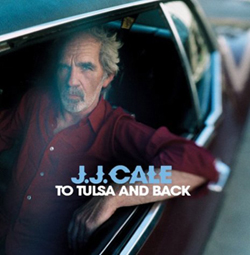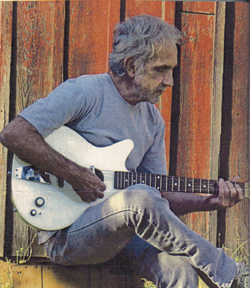 Johnny Cale saw himself primarily as a guitarist in the beginning. He sat at home listening to records figuring out difficult guitar licks and doing what you have to do to play an instrument. You play those patterns over and over and over until you’re sick of them and then your fingers start remembering on their own.
Johnny Cale saw himself primarily as a guitarist in the beginning. He sat at home listening to records figuring out difficult guitar licks and doing what you have to do to play an instrument. You play those patterns over and over and over until you’re sick of them and then your fingers start remembering on their own.
Gene Crose is credited with coaxing a reluctant Cale onto a stage. Cale didn’t think he was ready, but Crose had an ear for talent. Little did he know what he was setting in motion.
In those early days of Rock And Roll, big band swing was still somewhat popular, so players had to know some of that old stuff as well as the newer rock and roll that appealed to the younger parts of the audience. Cale knows more about music than is readily apparent.
Bobby Taylor quit his band The Valentines and guitarist Cale became the singer and band leader. He didn’t think of himself as a singer so the band played lots of instrumentals. One song he wrote “Purple Onion” became a single, and a popular brain teaser for a lot of guitarists. Mike Bruce said he spent a lot of time figuring out those licks.
Leon Russell had taken the big leap of faith and made quite a name for himself in Los Angeles as a session man and producer. He also utilized the talents of many Tulsans, such as Tommy Tripplehorn, Carl Radle, Jimmy Karstein, Larry Bell. and Jim Keltner. Cale came into this enclave and began working as an engineer under the tutelage of Leon and the great Bones Howe.
One project was a collection of psychedelic covers entitled “A Trip Down Sunset Strip” by The Leather Coated Minds. Cale said it was “Pretty awful – fortunately they didn’t press many of them.” But he liked some of the pyschedelic bands because they were getting new sounds out of guitars.
Cale also wrote some songs. One was a novelty tune, “Dick Tracy” that had funky syncopation and a lick lifted from the “Dragnet” Theme. He released a couple of singles on Liberty, the label that Garry Lewis was on.
He’s actually John Weldon Cale, but he got a gig offer at The Whisky Au Go Go. The owner had enough of Johnny Rivers and there was also John Cale with The Velvet Underground. He asked if he could book him as “J. J.” Cale said “You can call me whatever you like if we can have the job.”
 He came back to Tulsa and scuffled for gigs. He played lead with Don White’s band for a while, and in 1970 his life changed. Bobby Keys played Cale’s B-side “After Midnight” for Eric Clapton. Clapton recorded it and it became his first hit as a solo artist. Cale was reportedly playing at the Speedway Lounge out on the east side for $25 a night when he heard his song on the radio. In those days, royalty checks went out quarterly and he had to wait three months before he saw any money.
He came back to Tulsa and scuffled for gigs. He played lead with Don White’s band for a while, and in 1970 his life changed. Bobby Keys played Cale’s B-side “After Midnight” for Eric Clapton. Clapton recorded it and it became his first hit as a solo artist. Cale was reportedly playing at the Speedway Lounge out on the east side for $25 a night when he heard his song on the radio. In those days, royalty checks went out quarterly and he had to wait three months before he saw any money.
“Success determines what you are.” He noted. The guitarist turned singer and engineer now saw himself defined as a songwriter. His first solo album was recorded on a shoestring, with electric drums on several tracks. Much of it was done on a four track he carried around with him. It took him a while to come up with enough songs.
His songs have been covered many times. Clapton made another hit of Cale’s “Cocaine”- twice! Lynyrd Skynyrd moved a lot of units of “They Call me The Breeze” which was fired up by Okie Steve Gaines’ guitar work. Poco had chart action with the ballad “Magnolia”.
One story has it that Cale called his bank one day and asked if he had a million dollars yet. “Yes, Mr. Cale, you do.” They answered. He asked if he could see it. They probably had to request it from a federal reserve, and they set it in the vault. There was a phone there and Cale supposedly called some friends to say that he was looking at his first million.
This sounds uncharacteristic. Even though he’s set for life, for many years Cale lived in an Airstream Trailer in a park across from Disneyland. He indulged himself with some nice guitars and recording gear, but he’s kept his life as simple as his music. Many of his neighbors think he’s a truck driver.
That guitar on his first album was a cheap acoustic Harmony Sovereign. He liked the neck and the tone. At one time he had as many as five pickups attached to it. The back got broken in San Francisco but no local luthier had a back that would fit. Cale put a turnbuckle inside it to brace it up, and inadvertently solved the feedback problem. Though he has some priceless guitars, he played a $200 Danelectro at his last Cain’s gig.
At the Steve Munson tribute, Cale stood between Tommy Crook and Mike Bruce. You want notes? The three set off a blistering fusillade of improvised high-velocity riffing- in harmony! Cale has chops to burn, but he’s not a show-off. He knows what to leave out.
Success is the death of some people. Terrence Howard said “Fame and fortune don’t change a man. They unmask him. When you have no one to answer to, your real self comes out.”
Cale doesn’t have a mask; probably never did. He’s tried not to be famous, and though he has been very fortunate, he has put integrity first; in his music and the way he lives his life. He’s Okie through and through
About the author: Jim Downing is a lifelong musician and music historian. He has written and been published in countless publications over the past 30 years. His father was a columnist for the old Tulsa Tribune who wrote Downing’s Street
